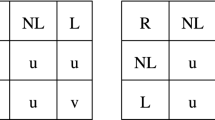Abstract
The main goal of this paper is to understand the reasons driving the coincidence of different allocation rules for different classes of games. We define a new symmetry property, reverse symmetry, and study its geometric and game theoretic implications. In particular, we show that most classic allocation rules satisfy it. Then, we introduce and study a notion of orthogonality between TU-games, which allows to establish a restricted additivity property for the nucleolus. Also, in our analysis we identify different classes of games for which all allocation rules satisfying some sets of basic properties coincide. These properties are satisfied, among others, by the Shapley value and the nucleolus.



Similar content being viewed by others
Notes
For a couple of exceptions see Brink (2007), where the author obtains characterizations of the equal division and equal surplus division solutions in which, essentially, the null player property in Shapley’s characterization is replaced with a nullifying player property (and translation covariance for equal surplus).
We use \(\subset \) for strict set inclusions and \(\subseteq \) for weak set inclusions.
Although throughout the paper we use the core to illustrate and motivate our analysis, in most of the figures we could have also used the Weber set or the core cover.
The statement for the core-center only applies to games where the core is nonempty. Since \(v\) is strongly reverse symmetric, nonemptyness of the core is equivalent to require that, for each \(S \subset N,\,v(S) \le 0\).
It is worth noting that orthogonality is related to the notion of decomposability introduced in Shapley (1971). Roughly speaking, a convex game is decomposable if and only if it is the sum of orthogonal games. Further, it is not hard to check that two zero-normalized games that are weakly orthogonal are also disjoint in the sense of van den Brink et al. (2006) and, therefore, orthogonal additivity will typically be weaker than disjoint additivity.
If the core is a singleton we define its (0-dimensional) volume to be 1.
The operation \(A+B\) denotes the Minkowski sum of the sets \(A\) and \(B\), i.e., \(A+B:=\{a+b: a\in A, b\in B\}\).
This version is just the adaptation of the approach taken in Kohlberg (1971) for the nucleolus.
We could as well rely on the less standard strong null player property (see, for instance, Peleg and Sudhölter 2003).
References
Chang C, Tseng Y-C (2011) On the coincidence property. Games Econ Behav 71:304–314
Chun Y (2006) A pessimistic approach to the queueing problem. Math Soc Sci 51:171–181
Chun Y, Hokari T (2007) On the coincidence of the Shapley value and the nucleolus in queueing problems. Seoul J Econ 20:223–237
Deng X, Papadimitriou C (1994) On the complexity of cooperative solution concepts. Math Oper Res 19:257–266
Dragan I (1996) On some relationships between the Shapley value and the Banzhaf value. Lib Mat 16:31–42
Gillies DB (1953) Some Theorems on \(n\)-Person Games. Ph.D. thesis, Princeton
González-Díaz J, García-Jurado I, Fiestras-Janeiro G. (2010). An Introductory Course on Mathematical Game Theory, vol. 115 of Graduate Studies in Mathematics. American Mathematical Society
González-Díaz J, Sánchez-Rodríguez E (2007) A natural selection from the core of a TU game: the core-center. Int J Game Theory 36:27–46. doi:10.1007/s00182-007-0074-5
Kar A, Mitra M, Mutuswami S (2009) On the coincidence of the prenucleolus and the Shapley value. Math Soc Sci 57:16–25
Kohlberg E (1971) On the nucleolus of a characteristic function game. SIAM J Appl Math 20:62–66
Maniquet F (2003) A characterization of the Shapley value in queueing problems. J Econ Theory 109:90–103
Maschler M, Peleg B, Shapley LS (1979) Geometric properties of the kernel, nucleolus, and related solution concepts. Math Oper Res 4:303–338
Peleg B, Sudhölter P (2003) Introduction to the theory of cooperative games. Theory and decision library. Kluwer, Dordrecht
Peters H (2008) Game theory: a multi-leveled approach. Springer, Berlin
Schmeidler D (1969) The nucleolus of a characteristic function game. SIAM J Appl Math 17:1163–1170
Shapley LS (1953) A value for \(n\)-person games. In: Kuhn H, Tucker A (eds) Contributions to the theory of games II, vol. 28 of annals of mathematics studies. Princeton University Press, Princeton
Shapley LS (1971) Cores of convex games. Int J Game Theory 1:11–26
Sobolev A (1975) Characterization of the principle of optimality through functional equations. Math Methods Soc Sci 6:92–151
Tijs S (1981) Bounds for the core and the \(\tau \)-value. In: Moeschlin O, Pallaschke D (eds) Game theory and mathematical economics. North Holland Publishing Company, Amsterdam, pp 123–132
Tijs S, Lipperts F (1982) The hypercube and the core cover of \(n\)-person cooperative games. Cahiers du Centre d’Études de Researche Opérationelle 24:27–37
Weber RJ (1988) Probabilistic values. In: Roth AE (ed) The Shapley value: essays in honor of Lloyd S. Shapley. Cambridge University Press, Cambridge, pp 101–119
van den Brink R (2007) Null or nullifying players—the difference between the Shapley value and equal division solutions. J Econ Theory 136:767–775
van den Brink R, van der Laan G, Vasil’ev V. (2006). Distributing Dividends in Games with Ordered Players. Tech. Rep. Tinbergen Discussion Paper 06/114-1, Tinbergen Institute and Free University, Amsterdam.
van den Nouweland A, Borm P, van Golstein Brouwers W, Groot Bruinderink R, Tijs S (1996) A game theoretic approach to problems in telecommunication. Manag Sci 42:294–303
Acknowledgments
We are grateful to Mikel Álvarez-Mozos, Gustavo Bergantiños, Juan Vidal, and two anonymous referees for helpful comments. We acknowledge the financial support of the Spanish Ministry for Science and Innovation through Projects ECO2008-03484-C02-02, MTM2011-27731-C03, and from the Xunta de Galicia through Project INCITE09-207-064-PR.
Author information
Authors and Affiliations
Corresponding author
Rights and permissions
About this article
Cite this article
González-Díaz, J., Sánchez-Rodríguez, E. Understanding the coincidence of allocation rules: symmetry and orthogonality in TU-games. Int J Game Theory 43, 821–843 (2014). https://doi.org/10.1007/s00182-013-0406-6
Accepted:
Published:
Issue Date:
DOI: https://doi.org/10.1007/s00182-013-0406-6



